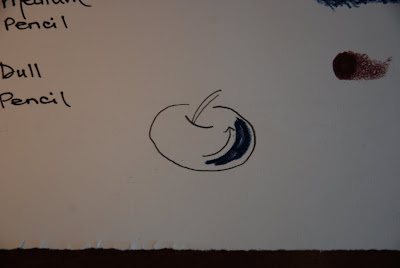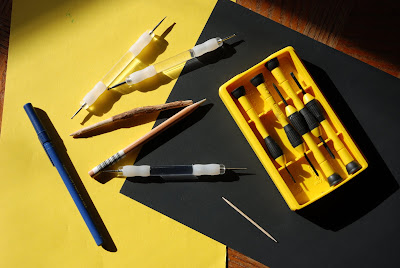
Wednesday, 30 September 2009
;-0

Monday, 28 September 2009
Ahhhhh! Done!
Friday, 25 September 2009
Baby Goldfish


Thursday, 24 September 2009
The Next Coloured Pencil Demonstration is Coming! I Promise!

Monday, 21 September 2009
 I am standing in the middle of the river. Usually I'm on top of the bridge. It seemed like a good idea at the time, to trudge down and rock skip to look at the bridge from below. This is the only time of the year when the water is low enough to do this. I'm facing the Ontario side.
I am standing in the middle of the river. Usually I'm on top of the bridge. It seemed like a good idea at the time, to trudge down and rock skip to look at the bridge from below. This is the only time of the year when the water is low enough to do this. I'm facing the Ontario side.Wednesday, 16 September 2009

Thursday, 10 September 2009

Wednesday, 9 September 2009
Coloured Pencil - Part III

Useful tools include some sort of soft brush or your own hot air to blow/brush away any pencil crumbs that can mark your paper in places you don't want it to; kneaded eraser to pick up colour by dabbing it on the place you want to lighten (I'll demonstrate as required when working on the painting.) and a paper with a hole punched out of it to assist you in determining whether or not your values are correct; If you happen to have an electric eraser around you are a lucky person and although it's not required, is a whole lot of fun. I use mine for blending as well as erasing and want to be burried with it when I die.

Follow the Contour

When we are using the above strokes we will still be following the contours of our object. You would not draw in straight vertical lines when colouring a curved object. You can still do a "linear stroke" while following the contour of our apple.

The sharper the pencil the better coverage you will get. Dull pencils tend to just slide over the tooth of the paper leaving a lot of the white. Sometimes this is valuble but for most of our painting we will require a sharp or medium sharpened pencil.

Okay....switch the names around then this will make more sense. Not enough coffee today I guess. Tuscan is the bottom scale and Indigo is the top scale.
You don't acually need to make a value scale, but they are useful and good practice. They will help you get a feel for how hard to press your pencil to get the value you want. You may already have some experience with creating value scales. If not, then basically you decide on a number of values (lightness and darkness) you would like to be able to obtain with one colour. You draw it at the lightest you can at one end and darkest at the other. Then fill in what you determine would be a good middle value. Then you fill in the rest going from lightest to darkest or vice versa. This will assist you to determine which value best matches the part of the photo you are drawing.

We will use impressed line to put the little pale dots on the apple. It involves using a pointy object to impress a small area, a dot, line, etc.... into your paper. Make sure the object is not sharp enough to cut through or score the paper. You just want to be able to "dent" the paper enough for the pencil to slide over the top of the paper in that section. If you use a spent pen make sure that there is absolutely no chance that any ink will come out otherwise you will ruin your painting. At this point you should each chocolate and start again at the beginning.

To impress a line use a piece of wax paper or tracing paper between your good paper and the stylus so that the stylus will in no way leave any undesirable colour marks behind. With a firm but not manic amount of pressure impress the lines, dots, etc... that you want to appear. Sometimes it helps to have them drawn out so you can see exactly where they are going. When you colour over the area you just impressed it's better to do so with a medium or duller pencil. You don't want to press into the impressed area with a sharp pencil or it will fill it in. On the otherhand, if you have impressed something in error, using a sharp pencil to fill in the impression is just what you want to do!
When you colour over the area you just impressed it's better to do so with a medium or duller pencil. You don't want to press into the impressed area with a sharp pencil or it will fill it in. On the otherhand, if you have impressed something in error, using a sharp pencil to fill in the impression is just what you want to do!
The last technique I want to quickly mention here is burnishing. This is akin to polishing your painting when it's done. If you use Prismacolor pencils they are wax based. When you have all of the layers and colours you want on your apple you can use a "colourless blender" which is a coloured pencil with no colour or a tissue or your dry finger. You polish the areas you want to shine and voila! It's all shiny just like a real store apple only without the pesticides!
If you put your painting aside at any point and notice when you come back to it that it looks duller or have a whitish film, this is called WAX BLOOM. You can re-polish it and the wax that has risen to the top will be removed once again showing the coloured pigment. The only way to totally avoid this is to spray your painting with a fixitive when you are completely done.
Wax bloom occurs generally when you are using dark colours or heavy layers of colours. The wax rises to the top and the pigment settles down below.
NEXT TIME:
Prepare to colour! I will post the pencil colours required once I start the painting myself and determine which ones we will require. The particular ones I choose may not be what you decide to use. Variety is the spice of life right?! (Mr. P. ....Ignore that last comment. It's not meant for you!)
Now....Go and eat some chocolate. I know I'm going to!
Tuesday, 8 September 2009
Coloured Pencil - Part II
Tape your original drawing to a bright sunny window with your low tack tape. Tape your good piece of paper over top. It's probably a good idea to make the good paper larger than the scrap paper. It will give you extra should you decide to frame your masterpiece or make additions to the setup. You will be using your window as a low tech light box.

Now GENTLY trace the image onto your good paper. DO NOT PRESS HARD! If you press too hard or use a hard leaded pencil it will impress a line in the paper to which the coloured pencil will glide over not leaving any colour. This is a technique we will be using later but not at this time. Also avoid using a pencil that is too soft as it will be more difficult to erase. I like to use a B lead.
You may wonder why we are bothering with this step and not sketching out our good copy directly onto the good paper. The less erasing and pencil marks you put on your good paper the better. Erasing flattens the tooth of the paper thus making it unable to take as much coloured pencil as you may like. The key to creating a coloured pencil painting with depth is to layer the colours on top of one another. For example we will use blue as our first colour to create the dark shaded side of the apple. We'll then layer various reds to give it depth and closer resemble the colour of an apple.
Now you are ready to start colouring. All of the lines you currently have on your paper will eventually be erased to be replaced by coloured pencil. In the end when your picture is done it will be all shading and no lines.
NEXT TIME:
Before we can actually tackle the apple we'll need to go over a few necessities. I'll post some examples of coloured pencil techniques, strokes used and suggestions. The meat and potatoes of the process as it were.
What you will need:
*a kneaded eraser
*coloured pencils (two colours would be great. I suggest Indigo blue and Tuscan red from the Prismacolour premier series collection. These can be purchased open stock for approx. 1.50 per pencil (Cdn) SEE NOTE BELOW
*Something pokey. A spent ball point pen, stylus, toothpick...you get the idea.
*A small piece of your good paper
*Chocolate (We're past the dog stage)
There are many good quality pencil companies out there. You need an artist quality pencil, not the student quality ones. Derwent and Faber-Castell also have wonderful pencils. If you choose one of these then pick a dark blue and brownish red. (heavier on the red side than brown.) These are two of the colours you will actually use to colour your apple when we start.
Wednesday, 2 September 2009
Free Coloured Pencil Lesson - Part I - Line Drawing


*pencil

Once you get a line drawing you are happy with and feel you can work from, use your black marker to outline all of the pencil marks. Make sure you also draw the line to indicate where you will put your shading and shadows as well as circling the area of the apple that will appear shiny and remain white.




